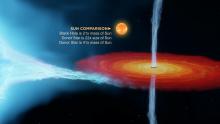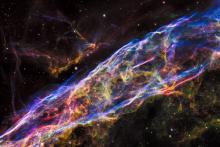Listen to today's episode of StarDate on the web the same day it airs in high-quality streaming audio without any extra ads or announcements. Choose a $8 one-month pass, or listen every day for a year for just $30.
You are here
Stellar Nurseries
A huge stellar nursery climbs high across the sky at this time of year. It’s near Deneb, the bright star that marks the tail of Cygnus, the swan. The whole complex is about 1800 light-years away. And it spans about 130 light-years.
The nursery consists of two bright clouds that are separated by a dark one. One of the bright clouds is well known — the North America Nebula. The other is the Pelican Nebula. Both are named for the figure their outline resembles.
The bright nebulae contain huge amounts of warm hydrogen gas. Ultraviolet energy from hot young stars in the nebulae give the hydrogen an electric charge, causing them to glow like neon bulbs. The dark nebulae contain dense clouds of cold gas and dust. Those clouds are also giving birth to new stars. But we can’t see the stars through the dust.
The bright nebulae reveal many “pillars of creation” — giant columns of gas and dust that contain newly forming stars. The pillars around the infant stars are being blown away by some of the stars that have already been born.
Astronomers have also seen “jets” of gas shooting away from several newly forming stars. The jets can stretch across billions of miles — heralding the birth of new stars in a busy nursery.
Look for Deneb high in the eastern sky this evening, at one point of the bright Summer Triangle. The nebulae stand just below Deneb, and are easy targets for a small telescope.
We’ll talk about another nebula in Cygnus tomorrow.
Script by Damond Benningfield






